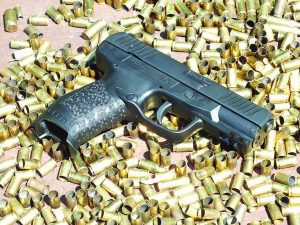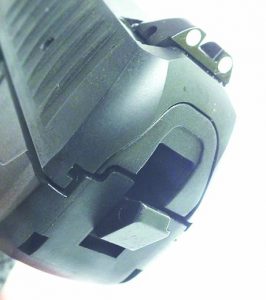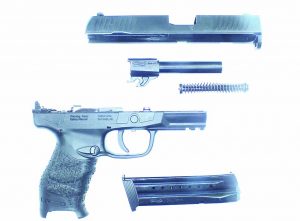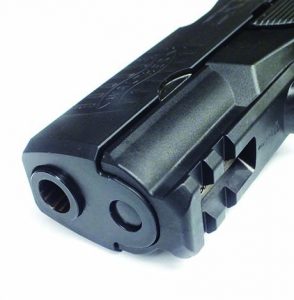by Dick Jones | Contributing Editor
Specifications
Model: Walther Creed
Action: Short recoil operated
Trigger: Striker fired, two stage
Caliber: 9mm Luger
Capacity: 16 +1
Magazines: Two steel blacked with witness holes
Barrel: 4”
Sights: Dovetailed two dot rear and pinned one dot front
Frame: Polymer
Slide: Steel, Tenifer
Length: 7.3”
Height: 5.6”
Weight: 27 oz.
Options: N/A
Accessories: Carry case, two 16-round blued steel magazines, cable lock, manual.
MSRP: $399.00
Website: waltherarms.com
Sometimes I see something that works, but I just can’t figure out why it was designed that particular way. Being a child of the generation who read Zen and the Art of Motorcycle Maintenance, I just drop back and make my evaluation based on performance, rather than “Why do it that way?” When I received a Walther Creed for review, I couldn’t figure out if I should describe it as a hammer-fired or striker-fired pistol and I still haven’t decided, but it works and that’s all that matters. Of course, all modern pistols and revolvers I can think of are really striker-fired. We stopped seeing firing pins on hammers a long time ago and if the firing pin isn’t on the hammer, there has to be some form of striker.
The modern acceptable term for a striker-fired gun in my mind is a gun that uses a linear system to cock and release the striker as opposed to a rotary motion of firing as it’s done with a hammer. Oddly, the Walther Creed seemed to be a bit of both. In all operational aspects, it’s a modern, polymer framed, double-stack pistol with a two-stage trigger system similar to almost all the other striker fired pistols that now grace the glass cases of gun shops everywhere. Walther describes it as “A pre-cocked double-action trigger system and a bobbed hammer that ensures a no-snag draw from concealment.” From the first PPK and P38 Walthers I shot as a young man, every Walther I’ve experienced has had a hammer. Personally, I think Walther just couldn’t stand the thought of building a gun without a hammer and incorporated one into the PPQ line whether the gun needed one or not.
Price over features

The Walther Creed was easy to shoot both accurately and fast. Fast follow up shots are required to knock down the Challenge Steel 8” Training Target and the trigger and sights made the task easy.
Other than the somewhat quirky firing system, the Creed is a standard, run-of-the-mill, modern striker-fired pistol. It’s based on the PPQ series as a less expensive alternative and lacks some of the features of the more expensive model. It comes with two high quality 16-round magazines with witness holes for ease of loading, a dovetailed two-dot rear sight and low profile pinned, single dot, front sight. The magazine release is in the standard position, easy to access, and can be reversed for left handed shooters. There’s a bottom rail for lasers and/or lights. The magazine well is tapered to allow faster insertion and magazines don’t just drop, they’re launched. The trigger is stamped with no blade or hinge for safety, the design relies on the length of stroke and internal blocks to prevent accidental discharges.

While the Creed looks like a standard striker fired gun, there is a hammer that rotates on an axle. This raises the bore axis to a bit higher than most striker-fired guns.
The main differences between the Creed and its more expensive brother are the trigger, the grip, slide release, sights, and component parts that are stamped rather than investment cast or machined to save money. Instead of the interchangeable grip system on the PPQ, there’s no interchangeable backstrap system. The PPQ has a bladed trigger system with a lighter pull and shorter reset stroke. While the trigger of the Creed was still quite good, the reset was noticeably longer. On the PPQ, the rear sight is adjustable for windage and it’s drift adjustable on the Creed. The PPQ has an ambidextrous slide release; on the Creed it’s just on the left side and stamped metal. There’s a hole through the rear sight and I suspect it’s the same part as on the PPQ but without the adjustment system. My first thought was that the hole was intentional and would allow for a shouldered pin punch to easily drift the rear sight for adjustment, but closer inspection gave credence to the former conclusion. Basically, the Creed is to the PPQ, what the base price, dog dish hub capped, Mustang was to the Mustang GT.
Test drive

The Creed is easy to take down with a rotating lever as are most modern pistols. There’s no need to drop the striker.
I tested the Creed with Winchester WinClean 124-grain and Silvertip 115-grain defensive loads. I experienced zero malfunctions during the testing, running about 350 rounds total through it. Recently, I received a Steel 8” Training Target from Challenge Target that’s a great testing device for defensive pistols. It’s an upright target frame for USPSA and similar targets with a hinge and steel plate that’s hidden behind the paper target. It’s adjustable for resistance so it can be set up to require three fast shots to knock it down with each shot driving it further back until it falls. If there’s too much time between the shots, it returns to rest.

The Creed is easy to take down with a rotating lever as are most modern pistols. There’s no need to drop the striker.
Driving the Steel 8” Training Target down with the Creed was easy. While the trigger reset on the Creed was longer than most striker-fired pistols I’ve tested, that’s a difference only experienced shooters would notice. The trigger broke with a bit of creep and it shot about two inches above point of aim. Most inexperienced shooters shoot low anyway and they won’t likely notice this either since it’s only two inches off at 15 yards. The sights were easy to see, the trigger was certainly light and precise enough for a defensive pistol, and recoil was mild. While the grip really felt nice in my hand, I’d have preferred a more aggressive texture. All these are issues serious shooters will observe, but I don’t think the target market for the Creed will notice them. Magazine changes were really fast and easier than a lot of guns I’ve tested. All the controls were where they should be and everything worked well.
Accuracy testing was done at 15 yards, deliberate fire, on a B34G reduced silhouette. In shooting fast, I hardly noticed the creep in the trigger, but when accuracy testing and trying for the best possible group, it was noticeable. Using 124-grain WinClean, I averaged about one and a half inches, which translates to pretty good accuracy for a pistol built with price in mind.
Matching the market

Like most full sized double stack pistols today, the 9mm Creed has a lower rail for lights and/or lasers.
The point is, Ford sold a lot of basic Mustangs, and with an MSRP of $399, I suspect Walther will sell a lot of Creeds. Searching online, I was able to find a new unfired Creed for $299 and several for $329. It’s true that most who read this article aren’t likely to buy a Walther Creed. Most experienced shooters would likely up the ante for the adjustable rear sight and better trigger on the PPQ. Having said this, I teach Concealed Carry Certification in my state, and there’re a lot of first time gun buyers. The Creed offers a lot of value for the money from a company with a great reputation. New gun buyers have little interest in whether parts are stamped, milled, or cast. Most are looking for a reliable gun that will accomplish the task of home or personal protection and the Creed certainly fills that bill.
In closing, would I buy a Walther Creed? The answer is no. Would I recommend it to the people who take my classes and who’ve never owned a gun? Yes I would, because the little issues that make it less than it could be are available in the PPQ but those folks would never notice them unless/until they become much more involved in shooting than 90% of them ever do. It’s a working pistol. It’s a six-banger Mustang with dog dish hubcaps, but like that original pony car, it’s fully capable of getting the job done.



